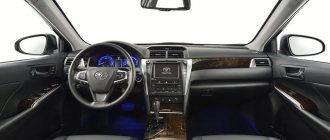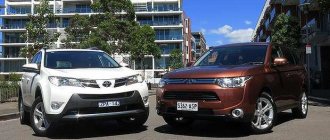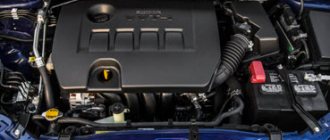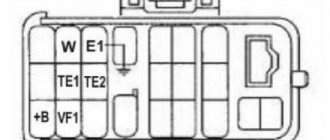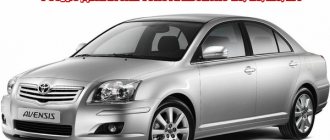Let's look at the advantages and disadvantages of the two rivals Corolla and Avensis. Let's go through the outside of the cars, look at the interior, and compare the strengths and weaknesses. Both Corolla and Avensis cars are from the wizards of the Japanese automotive industry. It is all the more interesting to compare power units, pricing policies, and perhaps we should listen to the opinions of those who have already driven these cars?
Exterior view from the side
The third generation Toyota Avensis is very presentable. Harmonious forms, as opposed to the futurism of individual elements, are fully consistent with the image of a modern urban handsome car, a modern type. The exterior is a kind of cake, layered with restrained dynamics and classic smooth lines and shapes. Encased in a tight ring of chrome decor. Looking at this external splendor, it seems that the Avensis is a higher class car.
Undoubtedly, in 2013, the Toyota Corolla was the most anticipated model. The update to this car has been awaited for almost fifty years. The manufacturers' idea to make cars inexpensive and of high quality turned out to be fully successful. The car was presented to motorists in the following configurations: L, LE and S. Toyota received a new wheelbase, 16-inch steel wheels, halogen headlights with multi-reflection, a chrome pipe, and heated mirrors.
In general, about the main differences between cars
Sedan-type bodies are available for the Corolla (a hatchback-type modification was offered on a number of generations); the Avensis was produced in sedan and station wagon bodies with an increased cargo compartment volume.
The appearance of the cars has common features (in the early 2000s, the fashion for a unified design of equipment within the same brand for cars of different classes began to gain momentum). However, there are differences in the shape of the body panels, bumpers and lighting equipment.
Avensis was positioned by Toyota as a vehicle with improved consumer characteristics. Foamed plastic was used to trim the interior, absorbing noise and vibration.
If you compare comfort for passengers, you will find differences in the profiles of the backrests and seat cushions, as well as in the design of the center console.
The manufacturer offered radios with a color or monochrome screen, equipped with a radio and a CD player (on expensive versions, a navigation system with a voice prompt was used).
Interior
The interior of the five-seater Avensis was covered with high-quality material by the finishing masters of the Land of the Rising Sun. This is immediately obvious when you first get acquainted with the car. But there is no pomp and pathos, all without unnecessary gloss, although the rich decoration catches the eye. We note the good ergonomics of the Avensis front panel. The steering wheel is comfortable and multifunctional. The cabin is spacious, and five passengers of average build will not push each other with their elbows; there is enough space for everyone.
The interior of the Toyota Corolla car was left behind cheap production. The style of the old days, part of the interior made of plastic after a while makes the driver and passengers shudder from an unpleasant squeak. There are positive points that need to be mentioned. We are talking, not surprisingly, about the simplicity of the interior. It is this that distinguishes the Corolla from other similar models. What else can be noted? Perhaps the seats are comfortable, on which even a “heavy weight” will be comfortable. There is enough space in the cabin, although the Corolla belongs to the sedan class.
Chassis
The fairly soft suspension of the Toyota Corolla makes the ride comfortable even on a bad road, where almost all shocks and shocks are successfully absorbed. The sound insulation of the body leaves much to be desired, in which impacts from pebbles on a country road can be heard, but the broken country road shows how perfectly the Corolla maintains stability and controllability on such a road.
The excessive softness of the Corolla's suspension on asphalt surfaces results in a slow response to the steering wheel and noticeable roll when turning and at decent speeds. However, it is worth noting that strong side winds and minor bumps prevent it from losing direction.
When choosing a Corolla or Avensis, it must be said that the latter model is designed for young drivers with a more aggressive driving style, and the Avensis suspension settings are more rigid. This affects itself when passing large holes and potholes on the road, but the steering wheel does not tear out of your hands and does not knock the car off course.
Unlike the Corolla, the Avensis has excellent sound insulation; no extraneous sounds are heard in the car. On smooth asphalt, the car accelerates steadily; acceleration is limited only by the low-power 1.6-liter engine. Joints in the road surface do not affect directional stability, nor does roll at high speed, and the car passes the famous asphalt waves on Russian roads without jolts or bouncing. All this makes the car's handling the best in class C.
Power unit or what was installed under the hood? Who's growling there?
On the Russian automobile market, Avensis was presented with three variants of gasoline engines with direct fuel injection and meeting Euro-4 standards.
- The 1.6-liter power unit with 132 l/power with a 5-speed manual transmission could accelerate to 100 km. in 10.4 sec. Fuel consumption figures are more than average: city - 8.3 liters, highway - 5.4 liters, combined cycle 6.5 liters.
- The 1.8-liter engine with 147 horses with a 5-speed manual transmission or Multidrive “variator” also showed average acceleration and fuel consumption results. Suffice it to say that in urban areas, the consumption of the Avensis was 6.7 liters.
- The most revered among Russian drivers was, of course, a car with a 2.0-liter engine producing 152 Japanese horses, which was coupled with a 6-speed manual transmission and a CVT. With a manual transmission, Avensis reached hundreds in 9.0 seconds. With the CVT the performance was slightly worse, 10.0 seconds. The speedometer limits in both cases were regulated by the figure 205 km/h. On average, a car with such a unit spent 6.9 liters with a manual transmission and 7.0 liters with a CVT.
Now there is no point in talking about the diesel engines that were on the Avensis. Due to their absence on the Russian market.
What else can be said about the positive? It is perhaps worth noting the five stars that Avensis earned while passing the EuroNCAP tests. Ensuring the safety of pedestrians near a car is somewhat worse.
Speaking about the technical characteristics of the Toyota Corolla, we note that the power of the power unit is 132 liters, with a volume of 1.8 liters paired with a manual transmission. Fuel consumption is also an important indicator. Fuel per 100 km, absorbs 8.7 in urban mode. On the highway, consumption is about 7 liters. In car models where a CVT is installed, the following indicators are: 6.9 liters per 100 km. A car with automatic transmission accelerates to 100 km/h in 10 seconds. Drawing conclusions, we can say that fuel economy is one of the positive features of the Corolla. When passing crash tests, the car also showed itself on the positive side. The differences between this model include the installation of three types of engines:
- Petrol.
- Diesel unit.
- Hybrid version with several subspecies.
I am pleased with the confident operation of the 5-automatic transmission in tandem with the specified engines.
Dynamics
To understand the difference, let's compare a Toyota Corolla with a 1.6-liter engine and a 2000 Avensis with the same engine size. Good traction at low and medium speeds of the Corolla engine allows the car to confidently pick up speed up to 4.5 thousand revolutions, after which acceleration becomes less energetic and confident.
The driver, in order not to lose acceleration dynamics, engages the next gear a little earlier and thereby loses time. But this factor is not so important if you do not participate in competitions. Fuel consumption here is low, only if it starts smoothly from traffic lights in the city. With an aggressive driving style, consumption increases to 9 liters or more.
It is fair to note that the Avensis engine with the same volume as that of the Corolla has 10 more horses, but the weight and dimensions of the car are larger. The rather large car quickly picks up speed, but the problem with the lack of traction at the top remains, however, thanks to the company’s engineers, this is no longer so noticeable.
When overtaking, there is some stretch in the gears of the manual transmission, which requires more time to complete the maneuver and adds excitement to the driver. The fuel consumption of the Avensis is comparable to the fuel consumption of the smaller Corolla and ranges from 6 to 8 liters per hundred kilometers.
Equipment
European car enthusiasts can choose one of six Avensis trim levels.
- Edition.
- Active.
- Select.
- Icon.
- Icon+.
- Excel.
The basic version is packaged well, not to mention the “top” Icon+ and Excel.
As we said earlier, the Corolla car is offered for sale in three models. The L model has a good audio system, which includes four speakers. Among its classmates, the Corolla stands out for its on-board computer. In the S and LE series, the acoustics come with six speakers. For ease of driving, cruise control is installed. In the vehicles of these models, an iPod is connected to USB.
Comparison of the cost of Corolla and Avensis
Prices for used cars at the beginning of autumn 2021:
- First generation Avensis, released in 2000-01. and is in good technical condition, will cost the buyer 340-380 thousand rubles. You can find cars cheaper than 200 thousand rubles, but in this case a major overhaul of the engine or body will be required. For second-generation cars, owners ask up to 780 thousand rubles. (copies produced in 2008-09 with mileages of more than 200 thousand km). Third generation Avensis are sold less often on the secondary market. The price reaches 1.2 million rubles. for equipment 2015-16. assemblies.
- Corolla in the back of E110 produced 2000-02. will cost the buyer from 350 to 390 thousand rubles. (instances with right-hand steering wheel). Representatives of the next generation E120 have a price of up to 560 thousand rubles. (regardless of the location of the controls). Cars with an E150 body in excellent technical condition are valued by owners at 800-950 thousand rubles. The E170 model will cost up to 1.4 million rubles. (2021 copies). Used E210s are rare on the secondary market (price up to 1.5 million rubles).
Comfort and cargo transportation
When you get into the Toyota Corolla, you are immediately pleased with the seats with a well-designed profile that reliably holds the driver during any maneuvers. In addition, there is no need to complain about ergonomics, since all the keys and switches in the Corolla are within reach and accessible at any time. The large three-spoke steering wheel of the Toyota Corolla, which in the first moments seems heavy, is actually very comfortable and allows you to drive the car without taking into account minor obstacles such as impacts from bumps that echo dull blows in the cabin. The Toyota manual transmission lever moves a little tightly in the grooves, however, the gear shifts are very clear, and the distances between the stages are large enough to prevent mistakes. In the maximum configuration, the Toyota Corolla is equipped with a large touch screen multimedia system and other expensive electronics, but the impression of cheapness is maintained due to the low height of the front panel and simple finishing materials.
The rear seat of the compact Toyota sedan can easily be called one of the best in the compact class. Three adults of average height can easily fit here, although they still have the “shoulder sense”. However, the Toyota Corolla does not upset its passengers either in terms of headroom or in the distance to the front row of seats. The trunk volume of 452 liters cannot be called a record, but the Corolla is ahead of many of its competitors in terms of ease of use of the cargo compartment. The loading height of the Toyota is low, and there are no strongly protruding wheel arches or low-hanging hinges inside.
If you are considering a Corolla or Avensis, it is worth saying in advance that the larger sedan has a fairly high cost, which explains the high quality of its interior trim. The high front panel of the Toyota Avensis looks solid, and the silver plastic of the center console is pleasant to the touch and visually highlights the main controls, allowing you to instantly find the right key. But the large dials of the Avensis dashboard with soft backlighting and large digitization look especially beautiful. The Toyota Avensis equipment also exceeds all expectations - in the maximum version you can find seven airbags, a multimedia system with a touch screen and a standard navigation system, as well as dual-zone climate control.
The front seats of the mid-size Toyota sedan are pleasing with perforated leather upholstery, which reliably holds a person, but they are disappointing with insufficiently high backrests, forcing the driver to constantly be in tension. The rear of the Avensis is even more spacious than the Toyota Corolla, but the increase in headroom is not very large. Three adults will feel comfortable here, but tall people will suffer from contact with the ceiling on large uneven surfaces. The Toyota Avensis trunk, with its volume of 509 liters, is also difficult to classify as a record, but in terms of ease of use it is not inferior to the smaller model participating in the comparison. The Avensis's cargo space is nicely shaped and padded to accommodate valuable, sensitive items.
A big difference
If it’s difficult to talk about the similarities of these two cars, then there is something to tell about their differences:
- Acceleration . Toyota Avensis surpasses Corolla in this indicator by 4 km/h.
- Fuel consumption . And here Avensis is ahead. It saves fuel by as much as 15% on the highway and 20% in urban driving.
- Ecology . Avensis emits less exhaust gases into the atmosphere.
- Price . This is where the Corolla earns itself a point. If its cost fluctuates around 350,000 rubles, then the cost of Avensis is approximately 500,000 rubles.
- The advantages of the Corolla over the Avensis include good handling and comfort on bad roads.
So what should you choose?
There is no clear answer to this question. If there is a monetary constraint, then it is preferable to buy a Toyota Corolla. If money is not an issue in choosing these two cars, then without even thinking about it, preference should be given to the Toyota Avensis.
If the car is purchased as a family car, then the advantage goes towards the Corolla, since its suspension is softer and comfort will not be impaired when driving on a bad road.
If a car is purchased by a young, energetic person, then it is better to give preference to Avensis, since the suspension tuning here will be stiffer and the overall dynamics of this car will be better.
Auto and motorcycleComment
Solution: Toyota Camry or Corolla
Camry is considered one of the most purchased cars. It is valued for its space, comfort and soft ride. This model is available in comparison with competitors of other brands as a business class car. It is worth considering the slight lack of comfort in the driver's seat.
A backrest that is too short creates tension on a person’s spine when driving for a long time. The Corolla is more impressive in appearance, more mobile, the disadvantages include the scarcity and small size of the interior. At the same time, the driver's seat is surprisingly comfortable, but rather low-slung. People taller than average will find it uncomfortable to drive. Although you can get used to everything.
Advice to buyers: if you value comfort, reliability and safety come first for you - choose the Toyota Camry; if you consider the economic aspect to be the main criterion for buying a car, then take a closer look at the affordable Corolla, devoid of internal luxury. Therefore, Camry is suitable for people who can afford not to cut their expenses, thereby providing comfort and peace.
Corolla positions itself as a driver's, youth, sports car, and, given its daring appearance, it has an economical engine. And with a hatchback body type, it also has a huge trunk.
We hope that our comparative analysis of Toyota Camry and Toyota Corolla was useful and instructive for you and you will be able to make your choice without much difficulty.
Ride quality
The moderately rigid suspension of the Avensis, tuned with high precision, determines high lateral stability and gives the driver the ability to maneuver at high speeds without the fear of losing course.
The Camry's suspension is the complete opposite of the Avensis - it is overly rolly and smooth, it does not allow the driver to take corners at high speed without risk. Even when driving on a straight road there is a feeling of “ruts”. But in the conditions of Russian roads, a soft suspension becomes an undeniable advantage - the shock absorbers easily absorb bumps, and in order to damage the car’s chassis you need to try hard.
Avensis T220 and Camry XV30
Based on the driving characteristics, you can choose an Avensis or Camry based on your driving style.
